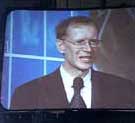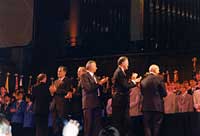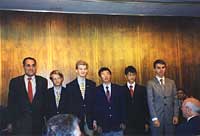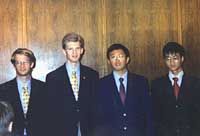
International Mathematical Olympiad 2001: Highlights of the Closing Ceremonies
The 42nd International Mathematical Olympiad (IMO) concluded July 13, with the awards ceremonies at the Kennedy Center and dinner at the magnificent National Building Museum. The Clay Mathematics Institute planned and hosted the Closing Ceremonies.
The Winners Are Announced!
The high school-age team from China ranked #1, and the teams from Russia and the U.S. tied for second place. Over a 2-day, 9-hour period, 473 students from 83 countries competed to solve 6 challenging math problems: 39 gold medals, 81 silver and 122 bronze medals were awarded at the event held in the John F. Kennedy Center for the Performing Arts. U.S. President George W. Bush greeted and praised the students via video.
Wiles and Witten Give Inspirational Talks

| Andrew Wiles and Edward Witten talked about the mathematical challenges ahead and directed their words of wisdom to the IMO student participants. Wiles addressed the young competitors by noting that the main differences between their IMO experience and the work of professional mathematicians are "scale" and "novelty". He pointed out that at the IMO they were competing against time and each other to solve solvable problems, and that when they pursue mathematics professionally they will need a new kind of stamina, creativity and willpower to solve the many old and new unsolved problems in mathematics. He said that their success "will require more than natural genius", that "there is no substitute for hard work", and that they "will need wisdom to choose problems and faith in their progress and solutions". His renowned work on solving Fermat's Last Theorem had obviously inspired the audience's admiration, as he was greeted and thanked with prolonged applause and cheers. The New York Times IMO coverage headline was "Young Math Competitors Pay Tribute to Their Hero" (July 15, 2001). |
Witten, a 1990 Fields Medalist, talked about the new challenges of the 21st century--challenges in the mathematical and theoretical sciences. He gave an overview of how mathematics underlies the basic theories of nature--quantum mechanics and general relativity--and how attempts to reconcile these theories has led to string theory (of which he is a leading exponent). He declared that there are "new worlds to explore as theorists and as experimentalists", and urged the IMO contestants to think about and pursue these challenges. Both Wiles and Witten displayed the appealing qualities of earnestness and modesty.
The Awards Are Presented
Then it was time for the students to receive their gold, silver and bronze medals. Their names were called one at a time, and they strode across the stage in all forms of attire, from suits to jeans and tennis shoes: a few draped themselves in their national flag. Each received a round of applause and had a photograph taken. The prize presenters were among the many prominent mathematicians, organizers and supporters of the IMO 2001: Rita Colwell (NSF Director), Claude Deschamps (IMO Advisory Board Chair), Ronald Graham (IMO Jury Chair, University of California, San Diego), John Kenelly (IMO 2001 President), Arthur Jaffe (CMI President), Landon and Lavinia Clay (Clay Mathematics Institute founders), Walter Mienka (IMO Executive Director) and Paul Sagan (President, Akamai Technologies). Kenelly and Deschamps had particularly warm words for the students who came from all over the world, who came from various intensities of training, and who took part in this great multi-cultural and intellectual gathering.



The Clay Mathematics Institute presented the CMI-IMO Award to the four perfect scorers in the 2001 IMO: Liang Xiao and Zhiqiang Zhang from China, and Reid Barton and Gabriel Carroll from the United States. Reid Barton of the U.S. was the first student ever to win four gold medals in the IMO.
All of the presenters and dignitaries praised the students for their talent and hard work, and declared that all were winners and slated to become the top scientists in their country. For a behind-the-scenes look at the preparations for IMO 2001, see "U.S. Hosts International Mathematical Olympiad", by Allyn Jackson, in the June/July issue of the Notices of the American Mathematical Society. Washington Post writer Lisa Allen-Agostini found some of the teens touring D.C. on a day off and quoted their perspectives in an article "The Sine of Things to Come" (July 11, 2001).
Science magazine published a long article on this year's IMO, "Top Young Problem Solvers Vie for Quiet Glory" (Dana Mackenzie, July 27, 2001). Accompanying the article were two sidebar articles, "IMO's Golden Boy Makes Perfection Look Easy" (about Reid Barton), and "Science Olympiads Offer a Variety of Arenas for Overachievers" (about comparable olympiads in physcis, chemistry, biology and informatics).
The Clay Mathematics Institute Honors Edward Witten and Stanlislav Smirnov
The CMI also presented its 2001 Research Awards to Edward Witten and Stanislav Smirnov. Witten was recognized for his "lifetime of achievement, especially for pointing the way to unify apparently disparate fields of mathematics and to discover their elegant simplicity through links with the physical world." Smirnov received the award "for establishing the existence of the scaling limit of two-dimensional percolation, and for verifying John Cardy's conjectured relation."
Press Conference Draws International Journalists
A Press Conference preceded the Closing Ceremonies, at which Kenelly, Deschamps and Graham announced the IMO 2001 winners. First, Arthur Jaffe, Paul Sagan, and Rita Colwell represented the primary academic, business and government supporters of IMO 2001—the Clay Mathematics Institute, Akamai Foundation, and National Science Foundation. They summarized their missions, concerns and plans. Colwell in particular addressed the "fear of math" in the U.S., and stated that the goals of the NSF are to change the image of math (to promote awareness of its beauty), to transform math education at all levels, and to fund math sciences and their links to other disciplines. She urged the mathematical community and the media to play a part in achieving these goals: "All of us are ambassadors for mathematics." Then the world's present and future ambassadors of mathematics--the teens from the first-place Chinese and second-place Russian and U.S. teams--were introduced and their photographs were taken. The four perfect scorers, Liang Xiao and Zhiqiang Zhang from China, and Reid Barton and Gabriel Carroll from the U.S., were also announced and introduced at the Press Conference.


The questions raised at the press conference were thought-provoking, and not easily answerable (although several on the panel provided insights):
"Is there a 'gender disconnect' in the U.S. and internationally? There are no young women on the Chinese, Russian and U.S. teams." [There were only 16 young women among all the award winners.] Colwell acknowledged that in the U.S., girls, minorities and many students drop interest in and do not excel in math in the elementary and middle school years, and that this needs to be addressed. Jaffe put forth that in other countries there seems to be less of a stigma attached to math, and to girls doing well in math. Kenelly pointed to Rita Colwell (the first woman to head the NSF) as a role model.
"Math has a more esoteric language than it did 20 years ago when I [a math physicist] studied math. Could this be a turn-off for students and the general public who don't see math's real-world applications?"Graham pointed to Witten as someone who bridges the sciences, and declared that "Math IS the language of science." Jaffe asserted that this is a time of exciting interface between math and physics, economics, biology, communication and engineering, all of which have revolutionized our lives. He suggested that we may not understand how work in math now may apply later. Colwell interjected that math is key in the genome project, among other fields. They acknowledged that the scientists in these fields are using the specialized language of mathematics, and that the goals are to better educate students in mathematics so that they may become the scientists of the future, and to better communicate to the general public these applications of math.
"To what do you attribute the success of the Chinese team?" The adult Chinese team leader firmly stated that they owed their success to the middle school teachers, and when asked if math was popular in China he laughed, "Yes." The adult Russian team leader attributed the Chinese success to hard work and intense training.
The Press Conference broke up and award-winners, journalists and photographers formed clusters as the students were interviewed about their training and about their impressions of the IMO 2001 experience.
IMO 2001 Sponsors
Major sponsors of the International Mathematical Olympiad 2001 were the Akamai Foundation, the National Science Foundation, the U.S. Department of Education, Wolfram Research, Texas Instruments, and the National Security Agency. The Clay Mathematics Institute hosted the IMO 2001 Closing Ceremonies and has many photos and video clips posted on its website. Several organizers and leaders were acknowledged at the gala dinner at the National Building Museum, and there were many more volunteers from near and far who helped with the competition and events, and who guided the students, team leaders and visitors before and during this international competition. The IMO participants enthusiastically cheered their leaders and local hosts, and the IMO flag was passed to next year's IMO host site: Scotland.
IMO 2001 was presented by an organization (IMO 2001, Inc.) comprised of 21 mathematics associations:
- American Mathematical Association of Two-Year Colleges
- American Mathematical Society
- American Statistical Association
- Assocation for Symbolic Logic
- Association for Women in Mathematics
- Association of State Supervisors of Mathematics
- Benjamin Banneker Association, Inc.
- Casualty Actuarial Society
- Conference Board of the Mathematical Sciences
- Consortium for Mathematics and its Applications
- Institute for Operations Research and Management Sciences
- Institute of Mathematical Statistics
- Mathematical Association of America
- Mu Alpha Theta
- National Alliance of State Science and Mathematics Coalitions
- National Association of Mathematicians
- National Council of Supervisors of Mathematics
- National Council of Teachers of Mathematics
- Pi Mu Epsilon
- Society for Industrial and Applied Mathematics
- Society of Actuaries

